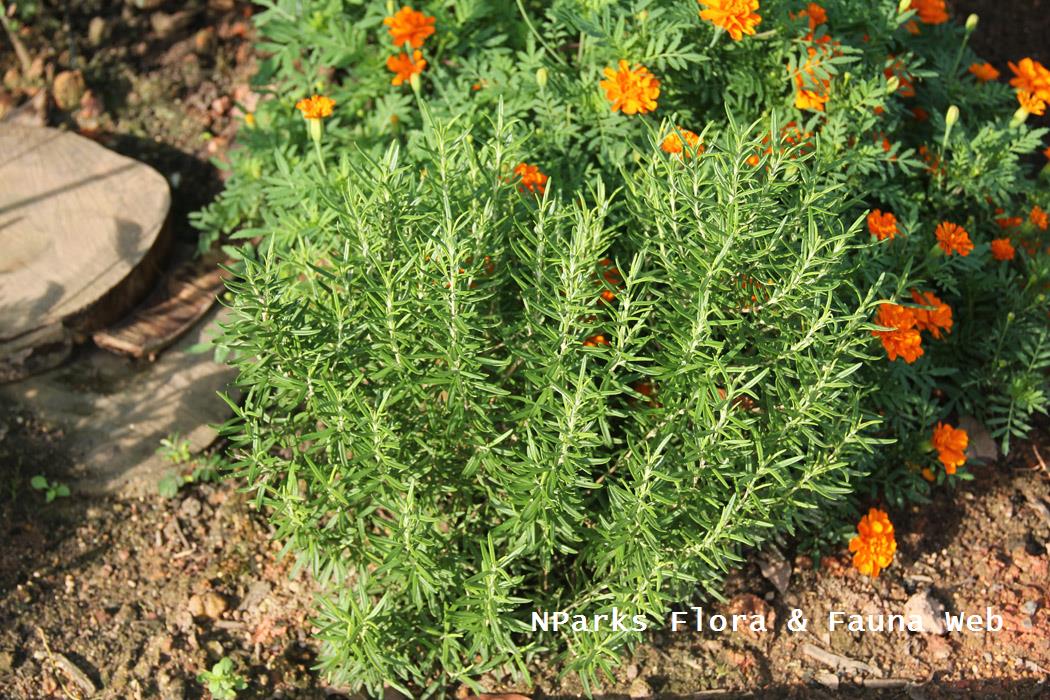
Back
Salvia officinalis L.
| Family Name: | Lamiaceae (Labiatae) |
| Synonyms: | Salvia chromatica, Salvia papillosa |
| Common Name: | Sage, Common Sage, Garden Sage, Broadleaf Sage, 撒尔维亚 |
Name
Classifications and Characteristics
| Plant Growth Form | Shrub |
|---|---|
| Lifespan (in Singapore) | Perennial |
| Maximum Height | 0.4 m to 0.7 m |
Biogeography
| Native Distribution | Greece, Albania, former Yugoslavia |
|---|
Description and Ethnobotany
| Growth Form | Perennial, woody subshrub are evergreen and have an erect or decumbent (horizontal) growth habit. |
|---|---|
| Foliage | Opposite leaves are lanceolate to ellipitic with entire leaf margin (1 - 10 cm long, 0.25 - 5 cm wide). Rugose leaves have a whitish, pubescent (softly hairy) underside. Young leaves are densely pubescent on both sides. |
| Stems | Young stems are tomentose (softly hairy) and 4-sided. |
| Flowers | Flowers have 2 equal-sized lips with an erect upper lip and curved, 3-lobed lower lip. Inflorescence resembles a raceme (spike-like inflorescence), but actually consists of several cymes. |
| Fruit | Each fruit is composed of 4 dark brown, smooth nutlets which are approximately round and 2.5 mm wide. |
| Cultivation | This species is easy-to-grow. Seeds may take 28 days to germinate. It should be planted in well-drained, acidic to slightly alkaline clay loam under full sun with 0.6 - 0.9 m space between individuals. Allow the soil to dry out slightly between watering sessions to minimise root rot due to overwatering. It is resistant to most pests (occasionally attacked by nematodes) and tolerates nutrient-poor soil and drought. While it can be grown in light shade, more essential oils are produced under full sun and warm temperatures. NPK fertilizer should be added to the soil before planting and about 6 - 8 weeks after planting. For plants grown as herbs, leaves should be harvested before flowering for maximum flavour. Propagate by seeds, stem cuttings, division or layering. In the tropical lowlands, such as Singapore, this species typically does not produce viable seed. |
| Etymology | The genus Salvia originates from the old Latin name of sage ("salveo") and means healer, referring to the various medicinal properties of sage. The specific epithet officinalis means that it is sold in shops as medicine. |
| Ethnobotanical Uses | Food (Herb or Spice): Dried leaves are used to flavour stuffings, sausages and cheeses. Medicinal: The essential oils have antibacterial properties. |
Landscaping Features
| Landscape Uses | Flowerbed / Border, Container Planting |
|---|---|
| Thematic Landscaping | Butterfly Garden |
Fauna, Pollination and Dispersal
| Fauna Pollination Dispersal Associated Fauna | Butterfly-Attracting |
|---|
Plant Care and Propagation
| Light Preference | Full Sun |
|---|---|
| Water Preference | Moderate Water |
| Propagation Method | Seed, Stem Cutting, Division, Ground Layering |
Foliar
| Mature Foliage Colour(s) | Silver / Grey |
|---|---|
| Mature Foliage Texture(s) | Rough |
| Mature Foliage Colour(s) Remarks | Greyish green |
Floral (Angiosperm)
| Flower Colour(s) | Purple |
|---|
Image Repository
Others
| Master ID | 30355 |
|---|---|
| Species ID | 4664 |
| Flora Disclaimer | The information in this website has been compiled from reliable sources, such as reference works on medicinal plants. It is not a substitute for medical advice or treatment and NParks does not purport to provide any medical advice. Readers should always consult his/her physician before using or consuming a plant for medicinal purposes. |





